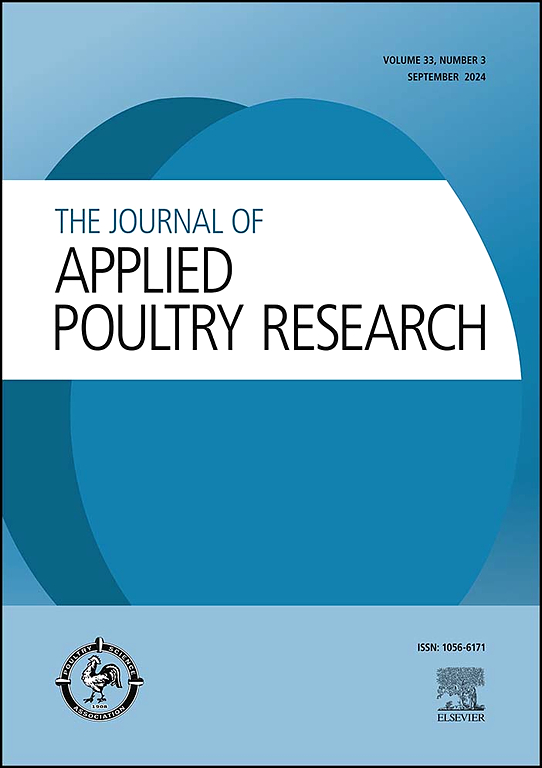低致病性禽流感病毒在水基家禽粪肥中的存活率
IF 2
3区 农林科学
Q2 AGRICULTURE, DAIRY & ANIMAL SCIENCE
引用次数: 0
摘要
几十年来,禽流感一直是美国一个日益严重的问题。低致病性禽流感(LPAI)病毒导致的发病率较低,而高致病性禽流感(HPAI)则对家禽业造成破坏性影响,导致全球范围内的高发病率和高死亡率。大型和小型家禽养殖场的粪便被作为肥料撒在庄稼地里。在农场爆发禽流感时,必须对粪便进行充分处理,杀死病毒后才能用于农业。在高温(55-65°C)下对家禽粪便进行水提取是处理家禽粪便的一种有吸引力的方法,它可以提取粪便中的营养物质并杀死有害微生物。最终产品是一种营养丰富的液体,可安全地施用到田地里或用于水培操作,与干粪相比,其营养成分对植物的生物利用率更高。不过,我们还不知道水基高温萃取工艺是否能完全杀死粪便中的禽流感病毒。本研究的目的是确定水提取家禽粪便对禽流感病毒灭活的能力。我们在生物安全二级柜中使用低致病性禽流感病毒分离物优化了这一程序。我们的数据表明,在温度≥ 55°C 的条件下对家禽粪便进行水提取处理一小时后,包括病毒血凝素蛋白在内的高致病性禽流感病毒被完全破坏。未来的研究将在 BSL3 设施中进行,以确定使用此优化程序灭活高致病性禽流感病毒所需的条件。本文章由计算机程序翻译,如有差异,请以英文原文为准。
Survivability of low pathogenic avian influenza virus in aqueous poultry manure fertilizer
Avian influenza has been a growing problem in the United States for decades. Low pathogenic avian influenza (LPAI) virus causes low morbidity, while highly pathogenic avian influenza (HPAI) has a devastating effect on the poultry industry causing high morbidity and mortality worldwide. Manure from large and small poultry operations is spread on crop fields as a fertilizer. During an outbreak of avian influenza on a farm, it is critical to adequately process the manure to kill the virus before its use in agriculture. Aqueous extraction of poultry manure at high temperature (55-65°C) is an attractive method for the treatment of poultry manure, which extracts the nutrients and kills harmful microbes from the manure. The end product is a nutrient-rich liquid that can be safely applied to fields or used in hydroponic operations, with nutrients that are more bioavailable to the plant compared to dry litter. However, we do not know whether aqueous high temperature extraction processes completely kill the avian influenza virus present in the manure. Our aim in this study was to determine the competence of the aqueous extraction of poultry manure on avian influenza virus inactivation. We optimized the procedure using a LPAI virus isolate in a biosafety level 2 cabinet. Our data indicated that the LPAI virus including the hemagglutinin protein of the virus was completely destroyed when the poultry manure was processed by aqueous extraction at temperatures ≥ 55°C for one hour. Future research will identify the conditions required for inactivating the HPAI virus using this optimized procedure by performing the study in a BSL3 facility.
求助全文
通过发布文献求助,成功后即可免费获取论文全文。
去求助
来源期刊

Journal of Applied Poultry Research
农林科学-奶制品与动物科学
CiteScore
4.10
自引率
10.50%
发文量
80
审稿时长
104 days
期刊介绍:
The Journal of Applied Poultry Research (JAPR) publishes original research reports, field reports, and reviews on breeding, hatching, health and disease, layer management, meat bird processing and products, meat bird management, microbiology, food safety, nutrition, environment, sanitation, welfare, and economics. As of January 2020, JAPR will become an Open Access journal with no subscription charges, meaning authors who publish here can make their research immediately, permanently, and freely accessible worldwide while retaining copyright to their work. Papers submitted for publication after October 1, 2019 will be published as Open Access papers.
The readers of JAPR are in education, extension, industry, and government, including research, teaching, administration, veterinary medicine, management, production, quality assurance, product development, and technical services. Nutritionists, breeder flock supervisors, production managers, microbiologists, laboratory personnel, food safety and sanitation managers, poultry processing managers, feed manufacturers, and egg producers use JAPR to keep up with current applied poultry research.
 求助内容:
求助内容: 应助结果提醒方式:
应助结果提醒方式:


